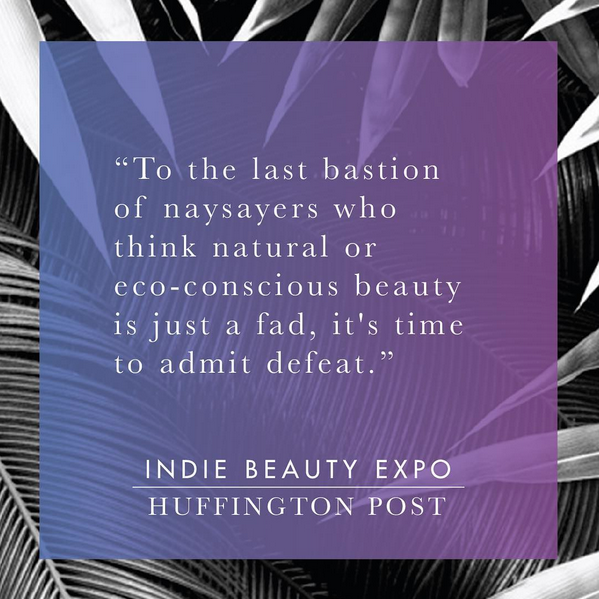Only five years ago, when we were launching Super by Dr. Nicholas Perricone into Sephora, indie beauty brands weren't really a thing. Their natural section was a single linear in the corner of the store. They told us that "green and clean" brands were a trend, and that focusing on ingredients NOT featured in the formulas wasn't important. Today, Sephora's Natural Beauty section features over 25 brands, each product boasting what it's formulated WITHOUT. Perhaps a bigger indicator that natural and organic indie beauty brands are the new normal is the launch and relevance of competing retail stores like Credo, The Detox Market, CAP Beauty, Shen and Follain, among many others. Blogs like Well + Good put health, wellness and natural beauty front and center, giving rise to a cadre of natural beauty bloggers and advocates, like Nitika Chopra, Beauty by Britanie, Sarita Coren, Kimberly Wallace and so many more.
But perhaps the most significant signal of things to come was the sold-out media and buyer frenzy that was Indie Beauty Expo, held in New York last month. Hailed as the 'Sundance Film Festival of Beauty', it was a 3-part, daylong expo featuring over 80 indie beauty brands, press, buyers and expert panel discussions. Weeks after the event, online media is still buzzing, and iBE founders Jillian Wright and Nader Naeymi-Rad are busy planning their 2016 events, to be held in NYC and LA.
 Glowing coverage from WWD, CEW and Huffington Post solidifies indie beauty's place in the mainstream, and we're beginning to feel the tables turning. Larger companies surely have their eye on these smaller brands, either to copy or acquire, as indie beauty brands grab more of the market share.
Glowing coverage from WWD, CEW and Huffington Post solidifies indie beauty's place in the mainstream, and we're beginning to feel the tables turning. Larger companies surely have their eye on these smaller brands, either to copy or acquire, as indie beauty brands grab more of the market share.
So, how do indie brands stay indie, preserving their authenticity as they scale?
Here are some tips through the eyes of a Mindful Marketer.First, be unapologetically specific. The only way to grab market share is to focus first on a very target audience, speak directly to them and do one thing really well. When we try to be all things to all people, it comes across as vague and uninspiring. We’re drawn to authenticity and our brains like specificity. Specificity doesn’t mean ignoring the masses. It means hyper-focusing on a target audience and making them feel heard, understood and taken care of. If done well, this creates a devoted segment of the market that can create a groundswell movement and cult following. That’s when the masses start to listen, and market share is earned organically, because you were doing what you do with intention and focus. Focus is power.
Don’t compete. Instead find the white space, which is intimately tied to your “why”. Consider unique and innovative distribution, like highly curated, niche partners who provide clout and press opportunities. Create new channels of distribution with affiliates, blog monetization models, ambassadors and influencers. Establish unlikely and news-worthy brand partnerships and collaborations. Focus on finding the most direct channels to reach your customers and speak to them directly. Find new ways to deliver the goods. Don’t compete with the big guys by doing what they do. Small brands can’t compete on budget and resources. So, do what they can’t do and what only you can do.
And remember, indie beauty brands, the ball is in your court. Here are just a few tips to maximize your assets and ride the indie beauty wave.
Face time. Giving spas, retailers and other partners access to the founder is good for early stages of brand building. Show up for trainings and events to give your partners individual attention. Brand Collaborations. Collaboration is the spirit of indie beauty, as Katie Hess of Lotus Wei so eloquently captured in her iBE recap, The New Paradigm is Here. Being small and privately owned means you're nimble. Find the few perfect partnerships and invest in creating something together. Examples are co-branded launch campaigns, customized amenities or exclusive treatment products. Or, collaborate with indie beauty's biggest advocate, Beauty Heroes, a non-toxic monthly subscription box that puts your brand in the spotlight with ingredient-obsessed consumers and 40 top spa directors and beauty experts. Influencer relationships. Identify the influencers who connect with your brand, your target audience and your target spa partners or retailers. Understand what these influencers are passionate about and if it aligns with your brand, make this relationship a priority. Influencers love discovery. They love authenticity, and they love delivering amazing content to their followers. Invest in create an influencer outreach strategy and be generous with your time and your products. (And again, this is where founder face time is a huge advantage.) Invest in brand styling. This is more than beautiful packaging and marketing collateral, which is essential. This is the day-in-day-out visual storytelling of the brand. It’s not enough to focus all marketing and design attention on the few big campaigns a year, or the new product launches. Every day, every picture on Instagram, every post, every piece of micro-content is a mini campaign. Become obsessed with consistency in visual storytelling and brand positioning. Become intentional about every brand detail. And if you don’t have time, hire someone to be obsessed for you. Know the new and evolving rules of social media. Social media is regular media. It’s #1 for brand awareness. While it may not be directly tied to conversion, it is directly tied to communication and brand curation. It is a day-to-day job of curating your brand identity across digital channels, creating micro-content marketing, connecting the experiential marketing initiatives back to digital platforms and identifying online collaboration opportunities to amplify your brand.
Stay tuned for more indie beauty tips...up next: how to prepare your brand to enter the spa market.

